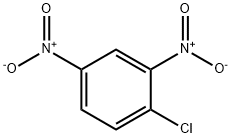1-클로로-2.4-디니트로벤젠
|
|
1-클로로-2.4-디니트로벤젠 속성
- 녹는점
- 48-50 °C(lit.)
- 끓는 점
- 315 °C(lit.)
- 밀도
- 314
- 증기 밀도
- 6.98 (vs air)
- 증기압
- 1 hPa (106 °C)
- 굴절률
- 1.5857
- 인화점
- 367 °F
- 저장 조건
- Store below +30°C.
- 용해도
- 알코올: 매우 약간 용해됨 (차가운)(lit.)
- 물리적 상태
- 결정질 덩어리, 덩어리 또는 결정체 및 분말
- 색상
- 노란색에서 갈색으로
- 냄새
- 아몬드 같은
- 폭발한계
- 1.9-22%(V)
- 수용성
- 불용성
- Merck
- 14,2136
- BRN
- 613161
- 안정성
- 안정적인. 타기 쉬운. 강한 산화제, 암모니아와 호환되지 않습니다. 히드라진 수화물과 격렬하게 반응함.
- LogP
- 2.24 at 23.3℃ and pH3.5-5.5
- CAS 데이터베이스
- 97-00-7(CAS DataBase Reference)
안전
- 위험 및 안전 성명
- 위험 및 사전주의 사항 (GHS)
| 위험품 표기 | T,N | ||
|---|---|---|---|
| 위험 카페고리 넘버 | 23/24/25-33-50/53-43-41-38 | ||
| 안전지침서 | 28-36/37-45-60-61-28A-24 | ||
| 유엔번호(UN No.) | UN 3441 6.1/PG 2 | ||
| WGK 독일 | 2 | ||
| RTECS 번호 | CZ0525000 | ||
| 자연 발화 온도 | 464 °C | ||
| 위험 참고 사항 | Toxic | ||
| TSCA | Yes | ||
| HS 번호 | 2904 99 00 | ||
| 위험 등급 | 6.1 | ||
| 포장분류 | II | ||
| 유해 물질 데이터 | 97-00-7(Hazardous Substances Data) | ||
| 독성 | LD50 orally in Rabbit: 640 mg/kg LD50 dermal Rabbit 130 mg/kg | ||
| 기존화학 물질 | KE-05627 |
1-클로로-2.4-디니트로벤젠 C화학적 특성, 용도, 생산
화학적 성질
yellow crystals with an almond odour용도
1-Chloro-2,4-dinitrobenzene is a benzene derivative and is used in biochemical research as a substrate for glutathione S-transferase.정의
ChEBI: 2,4-Dinitrochlorobenzene is a C-nitro compound that is chlorobenzene carrying a nitro substituent at each of the 2- and 4-positions. It has a role as an epitope, an allergen and a sensitiser. It is a C-nitro compound and a member of monochlorobenzenes.생산 방법
Although chlorobenzene can be dinitrated directly, this results in unnecessary isomer problems. 4-Chloronitrobenzene is usually nitrated with mixed acid (35/65) at 60 ℃ to give the pure dinitro isomer. However, 2- chloronitrobenzene can be nitrated to produce 2,4-Dinitrochlorobenzene, together with ca. 10 wt % of the isomeric 2- chloro- 1,3-dinitrobenzene. This may be separated for disposal, but the mixed isomers are preferably used directly if tolerated by the end product (e.g., sulfur dyes).일반 설명
Pale yellow needles, almond odor.반응 프로필
Self-reactive, [Halpern, Chem. and Eng. News, 29:2666(1951)]. The mixture of 2,4-Dinitrochlorobenzene with hydrazine hydrate caused a violent reaction.위험도
Toxic by ingestion, inhalation, and skin absorption. Combustible. Upper explosive limit 22%. A skin irritant.건강위험
TOXIC; inhalation, ingestion or skin contact with material may cause severe injury or death. Contact with molten substance may cause severe burns to skin and eyes. Avoid any skin contact. Effects of contact or inhalation may be delayed. Fire may produce irritating, corrosive and/or toxic gases. Runoff from fire control or dilution water may be corrosive and/or toxic and cause pollution.화재위험
Combustible material: may burn but does not ignite readily. When heated, vapors may form explosive mixtures with air: indoors, outdoors and sewers explosion hazards. Contact with metals may evolve flammable hydrogen gas. Containers may explode when heated. Runoff may pollute waterways. Substance may be transported in a molten form.색상 색인 번호
This substance is one of the strongest primary skin irritants known, and a universal contact allergen. Occupational dermatitis has been reported, but current use is decreasing or performed with completely closed systems. DNCB is sometimes used for topical treatment of alopecia areata, severe warts, and cutaneous metastasis of malignant melanomaSafety Profile
Poison by skin contact and intraperitoneal routes. Moderately toxic by ingestion. A severe human skin and eye irritant. Acts as a primary irritant as well as a sensitizer of skin. An allergen. Mutation data reported. Combustible when exposed to heat or flame. A moderate explosion hazard when exposed to flame, sparks, heated to 1 50°, or when shocked in a sealed container. Explosive reaction with ammonia at 17O℃/40 bar. To fight fire, use CO2, dry chemical. Reacts violently with hydrazine sulfate or hydrazine hydrate. See also NITRO COMPOUNDS of AROMATIC HYDROCARBONS.Purification Methods
Usually it is recrystallised from EtOH or MeOH. It has also been crystallised from Et2O, *C6H6, *C6H6/pet ether or isopropyl alcohol. A preliminary purification step is to pass its solution in *benzene through an alumina column. It has also been purified by zone refining. It exists in three forms: one stable and two unstable. The stable form crystallises as yellow needles from Et2O, m 51o, b 315o/760mm with some decomposition, and is soluble in EtOH. A labile form also crystallises from Et2O, m 43o, and is more soluble in organic solvents. The second labile form has m 27o. [Hoffman & Dame, J Am Chem Soc 41 1015 1919, Welsh J Am Chem Soc 63 3276 1941, J Chem Soc 2476 1957, Beilstein 5 IV 744.]1-클로로-2.4-디니트로벤젠 준비 용품 및 원자재
원자재
준비 용품
VAT 옐로우 4
디스페르스 블루 79
피크린산
2,4-디아미노벤젠 설폰산
Sulphur Yellow 9
트라이플루랄린(트리플루라린)
2,4-디니트로아닐린
Disperse Blue 301
2,4-DINITROBENZENESULFONIC ACID
Fast Scarlet RC Base
2,4-디나이트로페닐히드라진
Sulphur Black 1
2-(2,4-DINITROPHENOXY)ETHANOL
1-Methoxy-2,4-dinitrobenzene
2-AMINO-4-NITROPHENOL SODIUM SALT
2,4-디니트로디페닐아민
2,4-다이나이트로페놀
5-나이트로-o-아니스딘
Sulphur Dark Blue 3R
2-아미노-4-나이트로페놀
1-플루오르-2,4-디니트로벤젠
산성등색3호
1-클로로-2.4-디니트로벤젠 관련 검색:
1,2,4-트라이클로로벤젠 1,2,3-트라이클로로벤젠 클로로벤젠 에피클로로하이드린 3,5-디니트로-o-톨루아미드 1-클로로-2.4-디니트로벤젠 클로로디플루오르메탄 클로로아세트산 2,4-디클로로-3,5-디니트로벤조익산 M-디니트로벤젠 나이트로벤젠 1-클로로-3,4-디니트로벤젠 트라이나이트로클로로벤젠
1-tert-Butyl-4-chlorobenzene
5-CHLORO-2,4-DINITROTOLUENE
1,3-DICHLORO-2,4,6-TRINITROBENZENE
1,3,5-trichloro-2,4-dinitrobenzene
2,4-Dichloro-3,5-dinitrobenzotrifluoride










